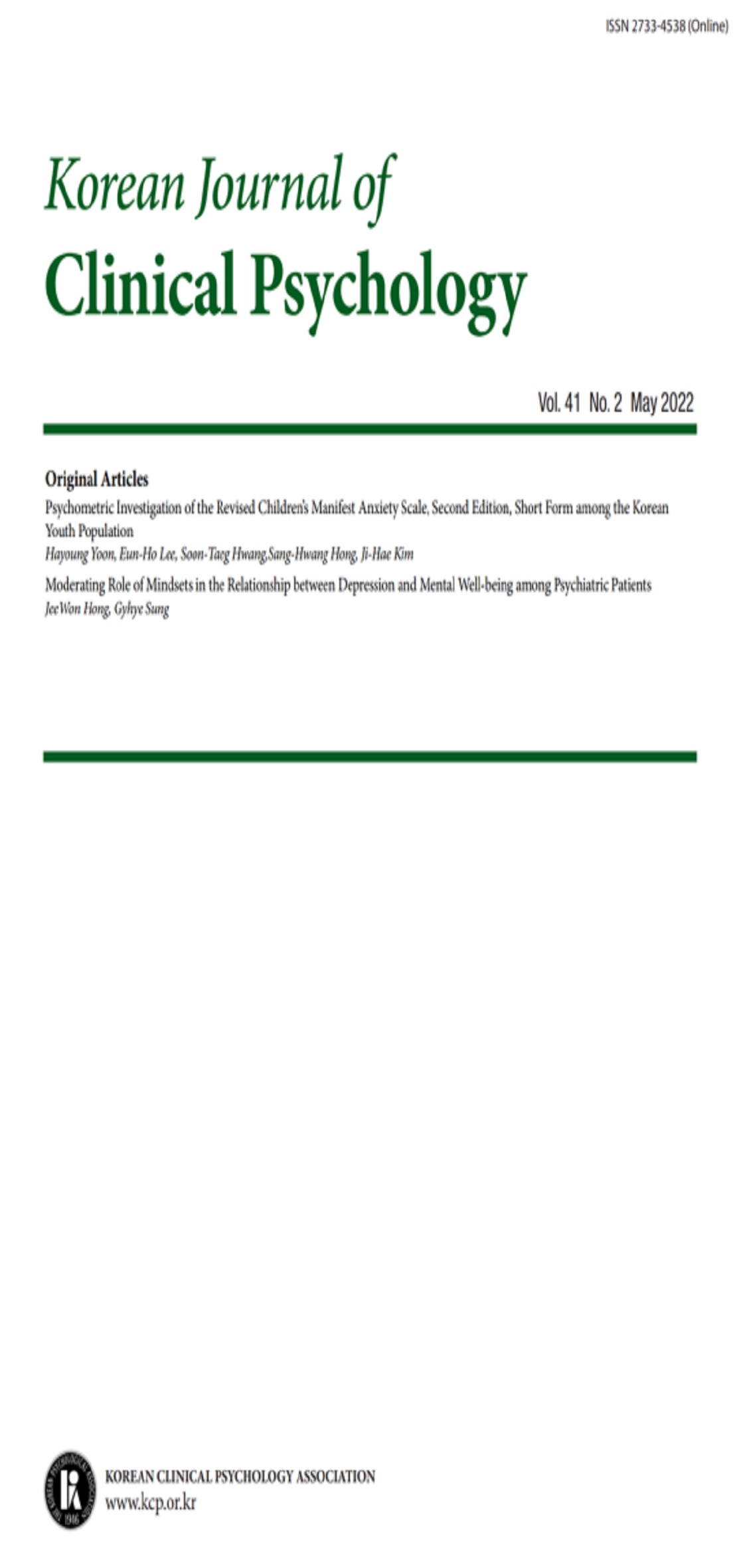open access
메뉴
open access
메뉴 E-ISSN : 2733-4538
E-ISSN : 2733-4538
The purpose of this study was to verify the validity and clinical utility of Korean version of the Child Behavior Checklist 1.5-5 in the screening of developmental delayed infants. The participants, who were screened by the Denver-II, included 40 developmental delayed infants(25 boys, 15 girls) and 326 normal infants(165 boys, 161 girls). Results indicated that the only 25 items among the CBCL 1.5-5 of total groups, 19 items of boys and 15 items of girls discriminate developmental delayed infants well. Further, discriminant validity was confirmed by mean differences on the subscales of Withdrawn, Attention Problems, Internalizing Problems, DSM Pervasive Developmental Problems and DSM ADHD between the two groups. Additionally, ROC analyses demonstrated that Withdrawn, Attention Problems, Internalizing Problems, Total Behavior Problems and DSM Pervasive Developmental Problems significantly predicted developmental delayed infants compared to normal infants. Also, the clinical cuttoff score criteria adopted in the Korean version of CBCL 1.5-5 for subscales of Withdrawn, Attention Problems and DSM Pervasive Developmental Problems were shown to be valid. However, the cutoff scores criteria for Internalizing Problems and Total Behavior Problems need to be lower by 55T. The implications of using the CBCL 1.5-5 in the screening of developmentally delayed infants and clinical suggestions were discussed.
박영숙, 박기환, 오현숙, 하은혜, 최윤경, 이순묵, 김은주 (2010). 최신 심리평가. 서울: 하나의학사.
박응임, 박성연 (1994). 낯선상황의 애착유형분류에 관한 일 연구. 대한가정학회지, 32 (3), 159-170.
박혜원, 조복희 (2006). 한국 Bayley 영유아발달검사(K-BSID-Ⅱ) 해석지침서. 서울: 도서출판 키즈팝.
신의진, 이경숙, 이재명 (2003). 0-3세 영유아기 정신건강 및 발달장애 진단 분류. 서울: 하나의학사.
신희선, 한경자, 오가실, 오진주, 하미나 (2002). 한국형 Denver-Ⅱ 검사지침서. 서울: 현문사.
오가실 (1976). Denver Developmental Screening Test의 한국 표준화를 위한 기초연구. 간호학논집, 1, 93-116.
오경자, 김영아 (2009). CBCL 1.5-5 유아행동평가척도 부모용. 서울: 휴노컨설팅.
오경자, 이혜련, 홍강의, 하은혜 (1997). K-CBCL 아동 청소년 행동 평가척도. 서울: 중앙적성 출판사.
이경숙, 신의진, 신동주, 전연진, 박진아 (2003). 한국판 영유아 행동문제 평가척도 표준화 예비연구. 한국심리학회지: 발달, 16(4), 175-191.
이근 (1996). 덴버 Ⅱ 발육 선별검사와 서울 아동의 발달에 관한 비교 연구. 소아과, 39(9), 1210-1215.
이진, 김영아, 오경자 (2009). 한국판 CBCL 1.5-5의 변별타당도 및 임상적 유용성. 한국심리학회지: 임상, 28(1), 171-186.
임희수, 박성연 (2001). 어머니가 지각한 아동의 기질, 어머니의 정서조절 및 양육행동과 아동의 정서조절간의 관계. 아동학회지, 23(1), 37-54.
전민철, 김영훈, 정승연, 이인구, 김종완, 황경태 (1997). 발달지체아에서 Denver Ⅱ의 유용성에 대한 연구. 대한소아신경학회지, 5(1), 111-118.
조수철, 김종흔, 최진숙 (1992). 한국판 걸음마기 기질평가 척도 개발. 신경정신의학, 31, 363-383.
천희영 (2003). 3-6세 조기중재 아동의 발견을 위한 PKBS. 아동학회지, 24(3), 151-164.
황혜정 (2005). 유아의 문제행동 진단을 위한 부모용 교사용 검사 개발 연구. 유아교육연구, 25(2), 235-257.
Achenbach, T. M. (1991). Manual for the Child Behavior Checklist/4-18 and 1991 profiles. Burlington: University of Vermont Department of Psychiatry.
Achenbach, T. M. (1992). Manual for the Child Behavior Checklist/2-3 and 1992 profiles. Burlington, VT: University of Vermont Department of Psychiatry.
Achenbach, T. M., & Rescorla, L. A. (2000). Manual for the ASEBA Preschool Forms & Profiles. Burlington, VT: University of Vermont, Research Center for Children, Youth, & Families.
Achenbach, T. M., & Rescorla, L. A. (2001). Manual for the ASEBA School-Age Forms & Profiles. Burlington, VT: University of Vermont, Research Center for Children, Youth, & Families.
Achenbach, T. M., & Rescorla, L. A. (2003). Manual for the ASEBA Adult Forms & Profiles. Burlington, VT: University of Vermont, Research Center for Children, Youth, & Families.
American Psychiatric Association. (1994). Diagnostic and statistical manual of mental disorders, 4th Ed. Washington, D.C., American Psychiatric Association.
Angold, A., & Egger, H. L. (2004) Psychiatric diagnosis in preschool children. In R Del Carmen-Wiggins & A Carter (Eds). A Handbook of Infant and Toddler Mental Assessment, New York: Oxford University Press.
Bayley, N. (1993). Manual for the Bayley Scales of Infant Development. San Antonio: The Psychological Corporation.
Buss, A. H., & Plomin, R. (1984). Temperament: Early Developing Personality Traits. Hillsdale, NJ: Lawrence Erlbaum.
Cloninger, C. R., Svrakie, D. M., & Przybeek, T. R. (1993). A psychobiological model of temperament and character. Arch Gen Psychiatry, 50, 975-990.
Fabes, R. A., & Eisenberg, N. (1992). Young children's coping with interpersonal anger. Child Development, 63(1), 116-128.
Feldman, M. A., Hancock, C. L., Reilly, N., Minnes, P., & Cairns, C. (2000). Behavior problems in young children at risk for develop-mental delay. Journal of Child and Family Studies, 9, 247-261.
Frankenburg, W. K., Dodds, J. B. (1967). The Denver Developmental Screening Test. Journal of Pediatrics, 71, 181-191.
Frankenburg, W. K., Dodds, J. B., Archer, P., Shapiro, H., & Bresnick, B. (1992). The Denver Ⅱ: A major revision and restandardization of the Denver Developmental Screening Test Ⅱ. Journal of Pediatrics, 89, 91-97.
Fullard, W., McDevitt, S. C. & Carey, W. B. (1984). Assessing temperament in one to three year old children, Journal of Pediatric Psychology, 9, 205-217
Garner, P. W., & Power, T. (1996). Preschooler's emotional control in the disappointment paradigm and its relation to temperament, emotional knowledge, and family expressiveness. Child development, 67(4), 1406-1419.
Lieberman, A. F., Barnard, K. E., & Wieder, S. (2004). Diagnosing infants, toddlers, and preschoolers: the zero to three diagnostic classification of early mental disorders. In: Delcarmen-Wiggins R, Carter A, editors Handbook of Infant, Toddler, and Preschool Mental Health Assessment. Oxford, U.K: Oxford University Press.
Luoto, M & Hjort, J (2005). Evaluation of current statistical approaches for predictive geomorphological mapping. Geomorphology, 67, 299-315
Reynolds, C. R., & Kamphaus, R. W. (1992). The Behavior Assessment System for Children, Teacher Rating Scales (BASC-TRS). Circle Pines, MN: American Guidance Service (AGS), Inc.
Sung, S. M., Kim, J. H., Yang, E., Abrams, K. Y., & Lyoo, I. K. (2002). Reliability and validity of the Korean version of the Temperament and Character Inventory. Comprehensive Psychiatry, 43(2), 235-243.
Wernar, C. (1994). Developmental psychopathology: From infancy through adolescence. NEW York: McGraw-Hill.
